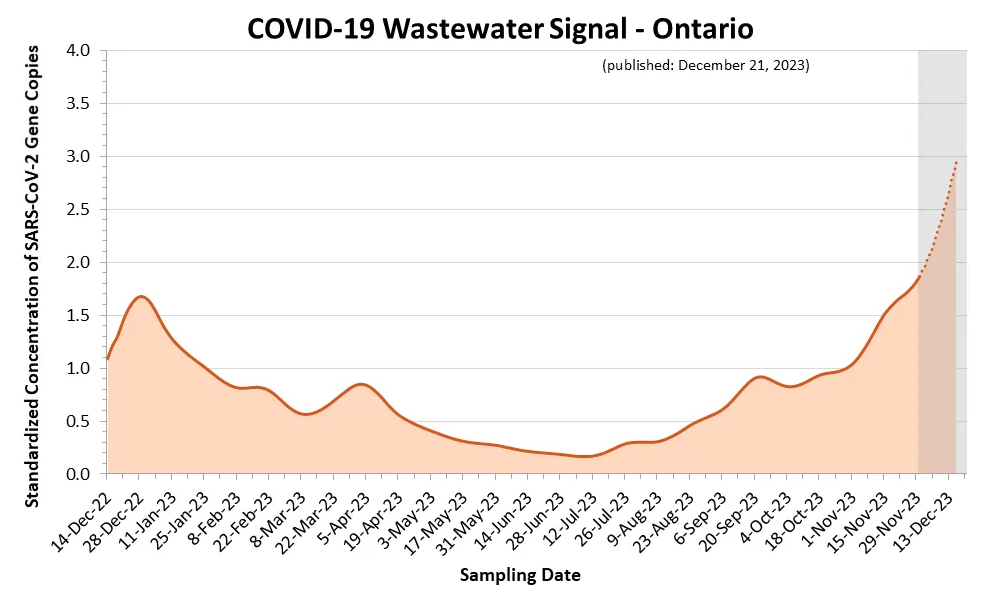More than 260 Ontario long-term care residents died after getting COVID-19 in last four months
 FILE - Sean Glass, a bartender at The Smiling Moose Bar/Restaurant, shows his COVID-19 protective covering he has at the ready Friday, May 14, 2021, in Pittsburgh's South Side neighborhood. (AP Photo/Keith Srakocic)
FILE - Sean Glass, a bartender at The Smiling Moose Bar/Restaurant, shows his COVID-19 protective covering he has at the ready Friday, May 14, 2021, in Pittsburgh's South Side neighborhood. (AP Photo/Keith Srakocic)
Respiratory virus outbreaks in Ontario’s long-term care homes remains dominated by COVID-19, with nearly 16,000 cases of the virus reported in the last four months.
According to a newly released report by Public Health Ontario, there have been 850 confirmed outbreaks in long-term care homes since Aug. 27, 2023.
This is compared to 32 influenza outbreaks and 32 Respiratory Syncytial Virus (RSV) outbreaks.
A facility has an outbreak when there are two or more test-confirmed cases with an epidemiological link.
- Download our app to get local alerts on your device
- Get the latest local updates right to your inbox
During this time period there were 15,958 reported cases among residents and staff, including 373 hospitalizations. Two hundred and sixty-three residents died after contracting the disease.
Six deaths occurred in residents who had been diagnosed with influenza and four were related to RSV.
The numbers were slightly lower in retirement homes, with 720 reported COVID-19 outbreaks and just over 10,000 cases among residents and staff. Fifty-five deaths were reported since late August.
The new data comes amid a surge of respiratory illnesses, with wastewater surveillance indicating a significant rise in COVID-19 across Ontario.
As of Jan. 3, the province has a test positivity rate of just over 19 per cent for the coronavirus, whereas influenza has a test positivity of under 10 per cent.
A “high” positivity rate for COVID-19 has been classified as being between 17 and 25 per cent.
These numbers only take test-confirmed cases into account, so it’s likely all the virus is much more prevalent. Wastewater surveillance data published Dec. 21 seems to indicate as such, with the signal standing at 2.96—the highest it’s been for at least a year.
 This chart by Public Health Ontario shows wastewater signals for COVID-19 increasing across the province.
This chart by Public Health Ontario shows wastewater signals for COVID-19 increasing across the province.
In central-east Ontario, excluding the Greater Toronto Area, that number is significantly higher, standing at about 3.51. In central-west it’s just a little lower at 3.26.
In the GTA itself, the wastewater signal is 3.6, the highest across the province.
Experts told CP24 last month that Ontario’s rising COVID-19 wastewater signal could be indicative of wave of COVID-19.
“There was a hope that it had started to plateau by late September, early October,” Dr. Fahad Razak, an internist at St. Michael’s Hospital and the former scientific director of the Ontario COVID-19 Science Table, said in early December.
“But in fact, unfortunately, it's gone the other direction and continues to rise quite steeply.”’
A decision was made in November to reinstate masking requirements in long-term care in an effort to curb the spread of respiratory illnesses.
The directive impacted staff, volunteers and support workers, who were mandated to wear masks indoors in all resident areas. It was also “strongly recommended" that caregivers and visitors wear masks indoors, except when in a resident’s room or when eating or drinking.
This was the first time masks have been mandated in long-term care since the province dropped the directive in October 2022.
CTV News Toronto reached out to the Ministry of Long-Term Care for information on how it will help reduce outbreaks in 2024, but received no response.
CTVNews.ca Top Stories

opinion Tom Mulcair: Prime Minister Justin Trudeau's train wreck of a final act
In his latest column for CTVNews.ca, former NDP leader and political analyst Tom Mulcair puts a spotlight on the 'spectacular failure' of Prime Minister Justin Trudeau's final act on the political stage.
B.C. mayor gets calls from across Canada about 'crazy' plan to recruit doctors
A British Columbia community's "out-of-the-box" plan to ease its family doctor shortage by hiring physicians as city employees is sparking interest from across Canada, says Colwood Mayor Doug Kobayashi.
'There’s no support': Domestic abuse survivor shares difficulties leaving her relationship
An Edmonton woman who tried to flee an abusive relationship ended up back where she started in part due to a lack of shelter space.
opinion King Charles' Christmas: Who's in and who's out this year?
Christmas 2024 is set to be a Christmas like no other for the Royal Family, says royal commentator Afua Hagan. King Charles III has initiated the most important and significant transformation of royal Christmas celebrations in decades.
Baseball Hall of Famer Rickey Henderson dead at 65, reports say
Rickey Henderson, a Baseball Hall of Famer and Major League Baseball’s all-time stolen bases leader, is dead at 65, according to multiple reports.
Arizona third-grader saves choking friend
An Arizona third-grader is being recognized by his local fire department after saving a friend from choking.
Germans mourn the 5 killed and 200 injured in the apparent attack on a Christmas market
Germans on Saturday mourned the victims of an apparent attack in which authorities say a doctor drove into a busy outdoor Christmas market, killing five people, injuring 200 others and shaking the public’s sense of security at what would otherwise be a time of joy.
Blake Lively accuses 'It Ends With Us' director Justin Baldoni of harassment and smear campaign
Blake Lively has accused her 'It Ends With Us' director and co-star Justin Baldoni of sexual harassment on the set of the movie and a subsequent effort to “destroy' her reputation in a legal complaint.
Oysters distributed in B.C., Alberta, Ontario recalled for norovirus contamination
The Canadian Food Inspection Agency has issued a recall due to possible norovirus contamination of certain oysters distributed in British Columbia, Alberta and Ontario.


































